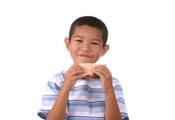“I’d rather buy my lunch at school,” says first-grader Kyle. “I’m afraid Mom will pack me something yucky if I take a lunchbox.”
 Take heart, Picky Eaters of America! Healthy eating doesn’t have to mean toting tofu and bean sprouts to school. Parents who understand what makes a lunch healthy can balance taste and nutrition in a way that turns “yuck” into “yum!”
Take heart, Picky Eaters of America! Healthy eating doesn’t have to mean toting tofu and bean sprouts to school. Parents who understand what makes a lunch healthy can balance taste and nutrition in a way that turns “yuck” into “yum!”
Does It Really Matter at This Age?
Making food choices that promote heart health is important at any age, according to Jamie Ross, Clinical Nutritionist at the Children’s Healthcare of Atlanta, Sibley Heart Center.
“These days, we are seeing more and more cases of children with metabolic syndrome,” Ross says. The children suffer from a combination of:
- Hypertension: high blood pressure
- Dislipidaemia: decreased HDL cholesterol and elevated trigylcerides in the blood
- Diabetes mellitus type 2: elevated insulin levels; “type 2 diabetes”
- Childhood obesity: overweight with fat deposits mostly around the waist
These same symptoms put children at increased risk for heart disease, the number-one cause of death and disability in America.
“The most affected seem to be our more sedentary kids who just don’t have good dietary habits,” Ross says. “Genetics is often a factor, but because we’re seeing symptoms younger and younger, it makes the scientific community think the trend may be largely due to habits and lifestyle.”
Dietary choices are important, even for “healthy” children. When children are active and naturally slender, parents may assume we can get away with less healthy choices, for now.
In most cases, children’s metabolisms do efficiently remove unhealthy nutrients from their bodies. But Ross cautions that even if our children don’t seem to be adversely affected, “later in life, they’ve developed a taste for that kind of food. Because that’s the taste they’ve acquired, it may be harder for them to switch to foods that are prepared more healthfully.”
Teaching our children healthy eating habits is part of the responsibility God entrusts to parents. The Bible is clear that parents are to “train up a child in the way that he should go.” We lay the foundation for habits our children are likely to carry through to adulthood.
There’s plenty that parents can do to protect our kids from the risk of heart disease. Starting now.
What Does “Heart Healthy” Mean?
Nutrition can be overwhelming. With so many “rules” out there, how can anyone reasonably evaluate what is important in a heart healthy diet? A heart-conscious parent’s mantra needs to be, “High Fiber – Low Fat – Low Sodium.” Here’s why:
High Fiber
“Fiber controls blood sugar levels and decreases the fats in your blood,” says Jamie Ross. Soluble fiber acts like a sponge that traps water-soluble fats, like cholesterol, and carries them from the body. Because fiber slows down the conversion of carbohydrates to sugar, “it also helps you feel full longer.”
Fruits and veggies are great, child-friendly sources of fiber. “Go as close as possible to the raw state of foods,” Ross says. “Kids don’t always like raw fruits and vegetables, but if you cut them into fun, easy-to-eat shapes, they’ll look more interesting. If it looks interesting, they’re more likely to touch it. And if you can get it into their hands, well, you’re halfway to their mouth!”
 “Don’t cut the skins from the fruits and vegetables,” she suggests. “That’s where the fiber is. The same goes for crusts of bread. In fact, go for the 100% whole wheat breads and whole grains whenever possible.” Ross also cautions parents to increase their child’s water intake as they gradually increase fiber “to keep the digestion flowing.”
“Don’t cut the skins from the fruits and vegetables,” she suggests. “That’s where the fiber is. The same goes for crusts of bread. In fact, go for the 100% whole wheat breads and whole grains whenever possible.” Ross also cautions parents to increase their child’s water intake as they gradually increase fiber “to keep the digestion flowing.”
Low Fat
“The trend seems to be toward eliminating fats,” says Ross. With the rise in public awareness about heart disease, “people are looking at transfats and hydrogenation and such, and that’s good.”
But it’s easy to go overboard, Ross warns. “Some fat is important in your diet for brain functioning, muscle functioning, and metabolism. The trick is to understand the whole picture. As a guideline, thirty percent of our calories should come from fat. So in a typical child’s diet of 1200 calories per day, that means 360 calories would come from fat—a total of 36 grams of fat per day.”
Always make an effort to choose leaner cuts of meat and remove any visible fat or skin. Also, keep in mind that a handful of nuts can deliver a good serving of protein, complete with a healthy dose of heart-friendly omega-3 and -6 fatty acids.
Low Sodium
“Sodium itself is not a bad nutrient,” says Ross. “Unfortunately, Americans are chronic abusers of sodium. The Recommended Daily Allowance (RDA) is only 2400 mg per day, but the typical American easily consumes 4000 to 5000 mg.” With the relationship between sodium abuse and high blood pressure clearly established, heart-conscious parents must be careful about limiting salt intake.
Keep in mind that “the more preserved a food is, the more sodium it has to have to make it shelf stable,” says Ross. Choosing foods that are fresher and less preserved can significantly cut sodium intake.
Although preserved, prepackaged lunch meals are quick and hassle free, “convenience comes at a price,” says Ross. Rather than offering your child a meal loaded with preservatives, try creating your own with squares of low-fat, low-sodium deli meats and cheeses, whole wheat crackers, and wafer-thin apple slices that your child can stack and build.
Tried and True Tips from America’s Healthiest Mom
Jyl Steinback is known by millions as “America’s Healthiest Mom.” As a former spokesperson for the American Heart Association, author of 15 bestselling cookbooks, and spokesperson for the Healthy Kids Nutrition Tour, Jyl is committed to helping kids feel better from the inside out.
What’s more, Jyl has the inside scoop on packing a wholesome lunchbox without the stress:
- Plan ahead. Pack the night before or, even better, pack once for the whole week. Make a date with yourself and your kids with a “no-cancellation” policy! The penalty for cancellation is disorganization, high-calorie, high-fat fast food meals, unauthorized lunch trades, and lots of stress!
- Encourage kids to take part in the selection, preparation, and packaging. Your child’s involvement not only reduces the risk of complaints, but also increases the possibility that they will EAT—rather than trade—their lunch. Don’t fret if they choose the same things day after day.
Consider little hands! Select easy-to-eat foods and use easy-to-open packaging. Pre-package your own snack food (baked chips, low-fat crackers, pretzels, etc.) in snack size bags for quick-fix lunches. - Pack a variety of snacks rather than one big sandwich. Try mini-muffins, cheese sticks and grapes. Favor “small” foods, like sandwiches cut in fun shapes or tortilla wraps cut in one-inch slices. Make a fun Kid Kabob by threading small pieces of low-fat turkey, cheese cubes, bell peppers and pineapple chunks onto Popsicle sticks (without pointy edges).
- Don’t get hung up on basic bread. Get creative. Try whole wheat pita pockets, tortillas, mini bagels, raisin bread, cinnamon bread, banana bread, rice cakes, or crackers.
- Include snack packs of veggies for dipping. Ideal dippers are baby carrots, grape tomatoes, celery sticks, broccoli, and cauliflower florets. Pack with a small container of low-fat ranch dressing or cottage cheese for fun dipping.
From Adversaries to Allies
Start slowly. Don’t obsess about making over the whole lunchbox immediately. Instead, “just slip in something new every once in awhile with something that’s familiar,” offers Jamie Ross. “When you make a PB&J, try adding half a banana or substitute sliced strawberries for the jelly.”
 Make some substitutions that your child won’t even notice. Opt for smooth-textured whole wheat bread or choose white bread that is fortified with wheat and fiber. Substitute low-fat versions of family favorites, like peanut butter and cheeses. Select fruit packed in natural juice instead of heavy syrup—or even better, send “smiles” of sliced fresh fruits.
Make some substitutions that your child won’t even notice. Opt for smooth-textured whole wheat bread or choose white bread that is fortified with wheat and fiber. Substitute low-fat versions of family favorites, like peanut butter and cheeses. Select fruit packed in natural juice instead of heavy syrup—or even better, send “smiles” of sliced fresh fruits.
Make it a point to tuck a heartwarming note in your child’s lunch box. Lunch hour is a great time to remind your child that you’re thinking of her. Slip in a thoughtful “I love you” note, a quick prayer of the day, or a silly joke that’s sure to touch her heart.
As you prepare and pack the lunch together, talk with your child. Find out his lunchbox favorites, and take the opportunity to encourage creative food choices. Caution him against judging other students for the foods they pack in their lunchboxes. Talk about being thankful for the food God provides each day. Look for the teachable moments and keep the lines of communication open!
Empower your child to make healthy choices for his own body. “Healthier lifestyles help kids with responsibility, respect, and caring for themselves and their bodies,” says Jyl Steinback. “When we take responsibility with healthy lunches, we respect ourselves.”
Remember your child is ultimately the one who decides what she puts in her body. To get her on-board with healthy eating, she needs to understand why food choices are important. Jamie Ross reminds parents that our bodies are God’s temple. “Healthy eating is one way to glorify God. Life is a gift,” she says. “We’re only given one life, one body. We really need to protect it and take care of it by doing whatever we can to help our bodies live a long time—without being plagued with diseases.”
 Jodi Knepper Jodi Knepper is a freelance writer from Reading, Pennsylvania, and she serves as Family Fitness Editor for Faith & Fitness. Jodi and her husband Darren have two young children—both insatiable fruit munchers.
Jodi Knepper Jodi Knepper is a freelance writer from Reading, Pennsylvania, and she serves as Family Fitness Editor for Faith & Fitness. Jodi and her husband Darren have two young children—both insatiable fruit munchers.For more information about Jyl Steinback’s health and weight loss programs or her latest cookbook, Fill Up to Slim Down, visit www.americashealthiestmom.com





